Урок англійської мови " Meetings"
Підготувала: Розумнюк Тетяна Валеріївна,
вчитель англійської мови
Броварського навчально-виховного об’єднання
What’s your name?
Greeting
(Grade 2)
Type of lesson: development of competencies
Objectives:
Students will be able to:
- greet people;
- meet people;
- ask and answer the question What’s your name?;
- learn new lexical units (hello, hi, good morning, good afternoon, good evening, good night, goodbye, What’s your name? My name’s… , everyone, come, fun, class, who, sorry, come on);
- become familiar with English language;
Equipment and materials: Smart board, disk with lesson 1(open file called les1.ppt), flashcards.
References:
- Sesame English. TV series.
- Fly High 2, Activity Book. Katherina Stavridou, Jeanne Perrett, Charlotte Covil, (2010), Pearson Education Limited
- Fly High 2, Fun Grammar. Katherina Stavridou, (2010), Pearson Education Limited
- Fly High 2, Pupil’s Book. Jeanne Perrett, Charlotte Covil, (2010), Pearson Education Limited
Procedure:
1. Warming-up.
- A teacher says “Hello” and encourages pupils to say “Hello” in response.
- Ask children to watch video. (slide 2 on the disk)
- Ask one child to stand up and say “Hello” or “Hi” to the children next to him/her. Encourage children to do the same in pairs, greeting each other.
- Point to yourself and say your name. “I’m…..”
- Ask children to watch video. (slide 3 on the disk).
- Encourage children to greet each other and say their names.
- Say “My name’s…” and ask pupils to say their names.
- Play a short game shouting “stand up” and “sit down”, where children have to follow your instruction.
2. Learning new vocabulary.
- Ask children to look at the smart board. Show them slides 4, 5, 6, 7 (you can also use flashcards) saying “morning”, “afternoon”, “evening”, “night”. Encourage children to repeat these words.
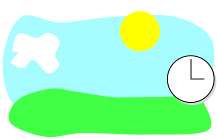
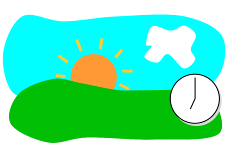


- Do it again but this time saying “good morning”, “good afternoon”, “good evening”, “good night”.
- Explain the difference in greeting people with Hello and Good morning.
- Show slide 8. Point to the pictures and recite the poem:
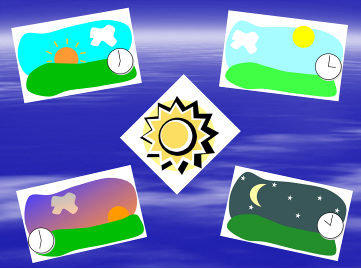
Morning, afternoon, evening, night.
Morning, afternoon, evening, night.
What do you say in the morning?
What do you say in the morning?
Good morning, good morning, good morning!
Morning, afternoon, evening, night.
Morning, afternoon, evening, night.
What do you say in the afternoon?
What do you say in the afternoon?
Good afternoon, good afternoon, good afternoon!
Morning, afternoon, evening, night.
Morning, afternoon, evening, night.
What do you say in the evening?
What do you say in the evening?
Good evening, good evening, good evening!
Morning, afternoon, evening, night.
Morning, afternoon, evening, night.
What do you say at night?
What do you say at night?
Good night, good night, good night!
3. Speaking and listening.
- Show the children slides 9, 10, 11, 12. Say the names for children to repeat in chorus.
- Ask children to greet them with “Hello Trumpet” etc.
- Show them slide 13, play the audio and ask to repeat.
- Show them slide 14, play the audio encouraging the pupils to point to the characters.
- Show them slide 15. Play the audio to listen to the chant several times to learn it.
- Ask children to chant but this time using their own names.
- Present slide 16. Ask children “Who’s this?” pointing to the characters for pupils to say their names. Ask them to describe the picture in Ukrainian.
- Play the audio pointing to the speech bubbles as children listen and look.
- Divide children into groups to make dialogues. They have to ask and answer the question “What’s your name?”
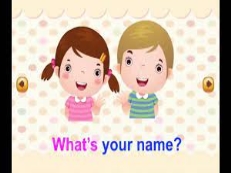
- Do the same with slide 17 but this time encourage pupils to ask each other “Who’s this?” pointing to different children in the class.

- Do the same with slides 18, 19 but this time encourage pupils to ask each other “How old are you?” and elicit answers helping them with numbers. Drill saying “I’m sorry” and “Goodbye”.
4. Feedback.
- Show the pupils slide 20 and present the English ABC.
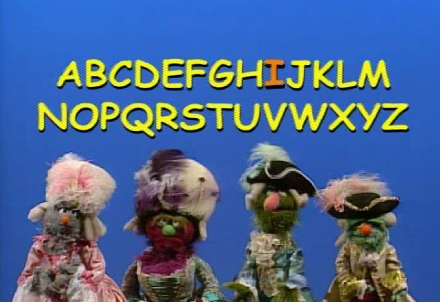
- Pupils watch the video and sing.
-
Homework. Students should:
- greet parents at home in different parts of the day;
- ask their names, and say goodbye when they go to school next morning.
1

про публікацію авторської розробки
Додати розробку
